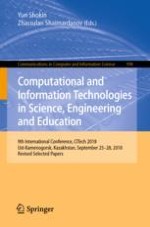2019 | Book
Computational and Information Technologies in Science, Engineering and Education
9th International Conference, CITech 2018, Ust-Kamenogorsk, Kazakhstan, September 25-28, 2018, Revised Selected Papers
Editors: Yuri Shokin, Zhassulan Shaimardanov
Publisher: Springer International Publishing
Book Series : Communications in Computer and Information Science
